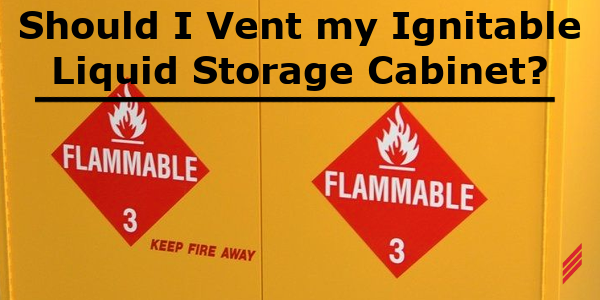Should I Vent My Ignitable Liquid Storage Cabinet?
by William Neuburger on Sep 23, 2022 11:12:19 AM

Our laboratory and industrial clients commonly store liquid chemicals in storage cabinets, commonly described as flammable storage cabinets. They deploy these cabinets to provide some security, contain small leaks, and increase the maximum allowable storage amount for their spaces.
They generally procure these cabinets as catalog items, which are listed to UL 1275, “Standard for Safety Flammable Liquid Storage Cabinets.” There are avenues to deploy liquid storage cabinets without a listing, but we rarely encounter them. These cabinets have common features from the UL standard, including self-closing doors, specific thermal performance, specific labelling, and ventilation connections.
The cabinets come with ventilation connections, 2” is a common size. Some of our clients prefer to vent their cabinets or occasionally the local adoption of the fire code requires it. When clients connect their cabinets to exhaust systems, they do so to manage odors or in a belief that venting improves fire safety. When venting, they would connect one cabinet vent connection with ductwork to an exhaust system and open the other connection to allow air from the room to flow into the cabinet. This is permissible by both model Fire Codes.
.png?width=610&name=Ignitable%20Liquid%20Storage%20Cabinets%20(1).png)
The annex material in the 2021 edition of the National Fire Code offers this guidance on the topic of ventilating cabinets:
“A.66.9.4.4 Venting of storage cabinets has not been demonstrated to be necessary for fire protection purposes. Additionally, venting a cabinet could compromise the ability of the cabinet to adequately protect its contents from involvement in a fire, because cabinets are not generally tested with any venting. Therefore, venting of storage cabinets is not recommended.”
We have reviewed both the National Fire Code (promulgated by the National Fire Protection Association) and the International Fire Code for the requirements of liquid storage cabinets. Download our Design Brief for a complete code analysis, our findings and recommendations .
About the Author
Bill has been a mechanical engineer since 1995 and with Hallam-ICS since 2010. His career has brought him to the top of the Transamerica Pyramid Center, chemical plants, underground mines, paper mills, and semiconductor fabrication facilities. He has experience designing, specifying and installing mechanical and electrical systems in the built environment covering industrial, institutional and commercial facilities.
Read My Hallam Story
About Hallam-ICS
Hallam-ICS is an engineering and automation company that designs MEP systems for facilities and plants, engineers control and automation solutions, and ensures safety and regulatory compliance through arc flash studies, commissioning, and validation. Our offices are located in Massachusetts, Connecticut, New York, Vermont and North Carolina and our projects take us world-wide.
You May Also Like
These Related Stories

It's a Small World

Industrial Sensor Data Integration with Ignition




Comments (1)